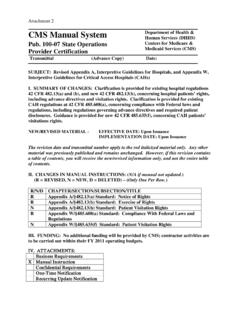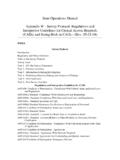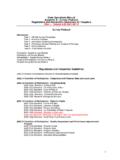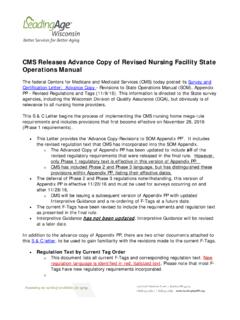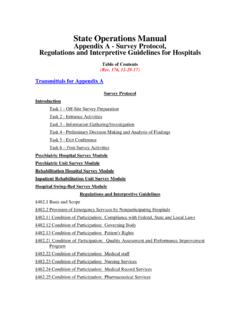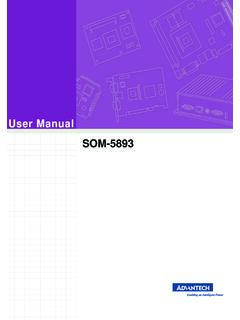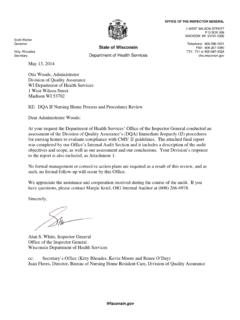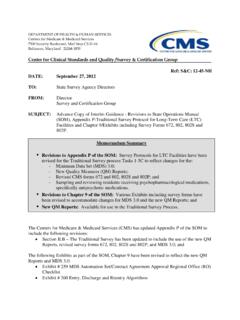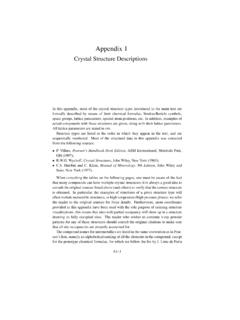Transcription of Appendix 1 - jcie.org
1 Appendix 1B W G C G H J C A working group on Challenges in Global Health and Japan s Contributions (informally referred to as the Takemi Working Group) was launched in September to look at global health in the context of human security a pillar of Japan s foreign policy as Japan was gearing up to host the Fourth Tokyo International Conference on African Development (TICAD IV) and the G Summit in Toyako, Hokkaido, in the spring and summer of . 2e Japan Center for International Exchange (JCIE) facilitated the launching of this group and has served as the G Hokkaido Toyako Summit, the world leaders proposed the Toyako G Common Framework for Action on Global Health, a framework for strengthening health systems around the world but particularly in develop-ing countries. But, in order for the many stakeholders in global health to come together to create that common framework, the stakeholders in the global health field need to develop a shared understanding of what health system means and a shared agenda for building its architecture.
2 Growing momentum among the major Japanese stakeholders in global health to begin to address these ques-tions led to the formation of a task force on Global Action for Health System Strengthening under the Takemi Working Group in September . 2e first phase of the working group s activities focused on ensuring that global health and human security remained high on the agenda of the Toyako Summit. During that phase, the working group members conducted site visits to learn more about the challenges and that developing countries face in improving health and some of the ways they are dealing with those challenges. 2rough an intense process of research and dialogue, the working group members de-veloped policy recommendations for the Japanese government as the summit host. 2e recommendations were discussed in seminars in Geneva, Washington DC, and New York and at a major conference in Tokyo.
3 2e working group Global Action for Health System Strengthening122also talked extensively with the key people in the government ministries and prime minister s office who were developing the summit agenda. Human security, which has grown to be a central pillar of Japan s foreign affairs, offered a useful framework for the working group s exploration of global health. As a demand-driven approach that attempts to address the intercon-nected challenges that threaten the lives, livelihoods, and dignity of individuals and communities around the world, human security seemed to be a natural framework for health issues, which go to the very core of human existence. 2e working group, which is led by Keizo Takemi, former senior vice minister of health, labor, and welfare, is unique in Japan in that it takes a participatory approach to impacting the summit agenda.
4 2e working group itself representa-tives from the three relevant ministries (foreign affairs; health, labor, and welfare; and finance), government aid agencies, academia, and NGOs. Just bringing together representatives from the three ministries for substantive discussion is rare in Japan, let alone bringing representatives from other sectors in to take part in the dialogue on an equal footing. 2e further discussions with experts and practitioners from around the world made it even more of a global and inclusive Toyako G Common Framework for Action on Global Health dem-onstrates that the G countries still take their commitments to improving the health of individuals and communities around the world seriously. 2e frame-work emphasized health system strengthening as a complement to the crucial disease-specific programs that are already saving countless lives.
5 2e Takemi Working Group chose to explore ways to implement the common framework by looking in depth at the three entry points for health system strengthening that were proposed at the summit: the health workforce, health system monitoring and evaluation, and health financing. 2e Takemi Work Group is also explor-ing the overall question of building integrated health systems that are able to respond to the challenges of providing primary healthcare while also tackling individual diseases, to achieve the health-related Millennium Development Goals, and ultimately to enhance the health and human security of people around the world. 2e papers presented in this volume are the result of the first stage of that exploration. As a follow-up to the G Summit, this group has been reorganized to pursue four primary goals. 2e first goal is to identify concrete activities for health system strengthening based on the Toyako G Common Framework for Action on Global Health.
6 A second goal is to ensure that the political momentum on health system strengthening that was achieved over the past year under the leadership of Japan is transformed into concrete action and to 123 Appendicesensure continuity in the process of moving toward the G Summit, to be hosted by Italy, and beyond. 2ird, this project aims to identify ways in which the many stakeholders in this field around the world can reach consensus on concrete actions to be taken for health system strengthening and develop part-nerships for joint implementation. Finally, the project aims to explore ways in which the G itself can play a catalytic role in global health policy making. In all of its activities, the Takemi Working Group acts as a catalyst to synthesize existing initiatives for health system strengthening around the world within the framework of human international task force of global health experts from various sectors from around the world was launched in September to further explore the three building blocks and offer policy recommendations, guided by an international advisory board comprising some of the world s top scholars and practitioners in this complex field.
7 2ree research teams were created within the task force, one for each of the entry points discussed above. Each research team was tasked with preparing concise, action-oriented policy papers, which were discussed at a workshop on October and a major international con-ference in Tokyo on November on Global Action for Health System Strengthening. Discussion at both events was enriched by the participation of many of the top experts in this field representing a diverse range of orga-nizations and sectors. 2e product of this intense process of research and dialogue, contained in this report, was submitted to the Japanese government in January , which in turn presented the paper and its recommendations to the Italian government. JCIE and the Takemi Working Group are working in collaboration with the government of Japan (Ministries of Foreign Affairs; Health, Labour and Welfare; and Finance); the Bill & Melinda Gates Foundation; the Rockefeller Foundation; the World Health Organization; the World Bank; the Global Fund to Fight AIDS, Tuberculosis and Malaria; and other stakeholders.
8 Appendix 2W G C G H J C List of MembersChair: Keizo T Research Fellow, Harvard School of Public Health; Senior Fellow, Japan Center for International Exchange (JCIE)Director:Tadashi Y President, JCIE (alphabetical order)Kazushi H Executive Director, Japan Bank for International CooperationMasami I Executive Board Member, Japan Medical AssociationSumie I Managing Director and Executive Secretary, Japanese Organization for International Cooperation in Family Planning (JOICFP)Masamine J Professor, Department of International Community Health, Graduate School of Medicine, University of TokyoYasushi K Professor, Waseda University Graduate School of Asia-Pacific StudiesKiyoshi K Professor, National Graduate Institute for Policy Studies (GRIPS); Chairman, Health Policy Institute, JapanDaikichi M Deputy Director-General, International Bureau, Ministry of FinanceTaro M Assistant Minister for International Affairs, Ministry of Health, Labour and Welfare125 AppendicesYasuhide N Professor, Department of International Collaboration, Graduate School of Human Sciences, Osaka UniversityYohei S Chairman, Nippon FoundationTakehiko S President Emeritus, International Medical Center of JapanTakashi T Assistant Minister for Technical Affairs, Minister s Secretariat, Ministry of Health, Labor and WelfareShinsuke S Director-General for Global Issues, Ministry of Foreign AffairsYoshihisa U Vice President, Japan International Cooperation Agencyas of January , Appendix 3G A H S S International Advisory BoardUche A Director of the African Programme for Onchocerciasis Control (APOC)
9 , World Health Organization (WHO), Burkina FasoLincoln C President of the China Medical Board, USAD avid D F Executive Director, Global Health Initiative, Brookings Institution, USAJ ulio F Executive President, Carso Health Institute, MexicoYan G Professor in Health Policy & Management, School of Public Health, Peking University, ChinaRichard H Editor-in-chief, Lancet, UKWilliam H K. T. Li Professor of Economics, Harvard School of Public Health, USAJim Young K Director of the Fran ois-Xavier Bagnoud Center for Health and Human Rights (FXB), Harvard School of Public Health, USAE duardo M Adjunct Professor, Centre for Health Care Research (CERGAS), SDA Bocconi Postgraduate School of Management and Department of Institutional Analysis and Public Management, University Luigi Bocconi, ItalySigrun M Ambassador for HIV/AIDS, Ministry of Foreign Affairs, NorwayShigeru O Regional Director, WHO, Regional Office for the Western Pacific, PhilippinesPeter P Executive Director, Joint United Nations Programme on HIV/AIDS (UNAIDS), Switzerland127 AppendicesSujata R Additional Secretary and Director General, National AIDS Control Organisation (NACO), IndiaMiriam W Laureate, Hideyo Noguchi Africa Prize.
10 Chairperson of the National AIDS Control Council (NACC), KenyaSuwit W Senior Advisor, Ministry of Public Health, 2ailandAppendix 4T F G A H S S List of MembersDirectorKeizo T Research Fellow, Harvard School of Public Health; Senior Fellow, JCIEO verview Co-authorsKeizo T Michael R Taro Takemi Professor of International Health Policy, Harvard School of Public Health, USAL iterature ReviewYasushi K Associate Professor, Waseda University Graduate School of Asia-Pacific Studies, JapanTamotsu N Director, Expert Service Division, Bureau of International Cooperation, International Medical Center of JapanYasuhide N Professor, Department of International Collaboration, Graduate School of Human Sciences, Osaka University, JapanResearch TeamsHealth InformationDirector:Kenji S Professor, Graduate School of Medicine, University of Tokyo129 AppendicesSpecial Advisor:Christopher J.


